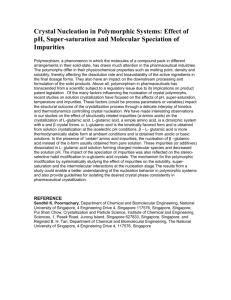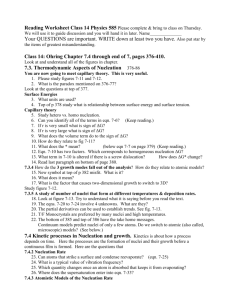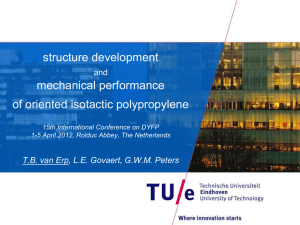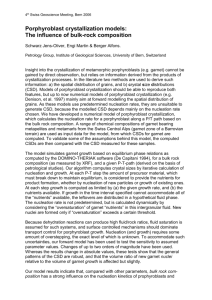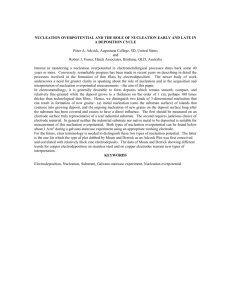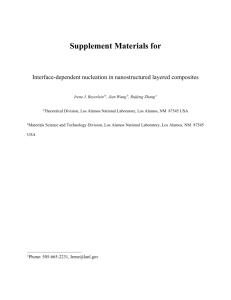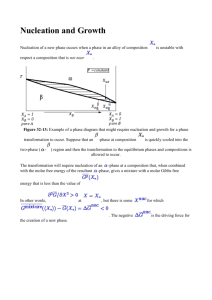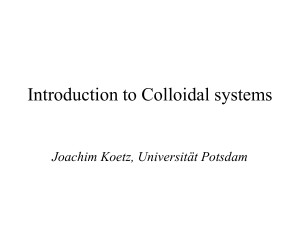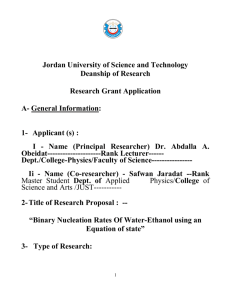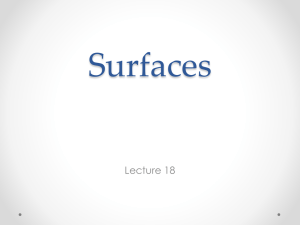PPT - Kfki
advertisement
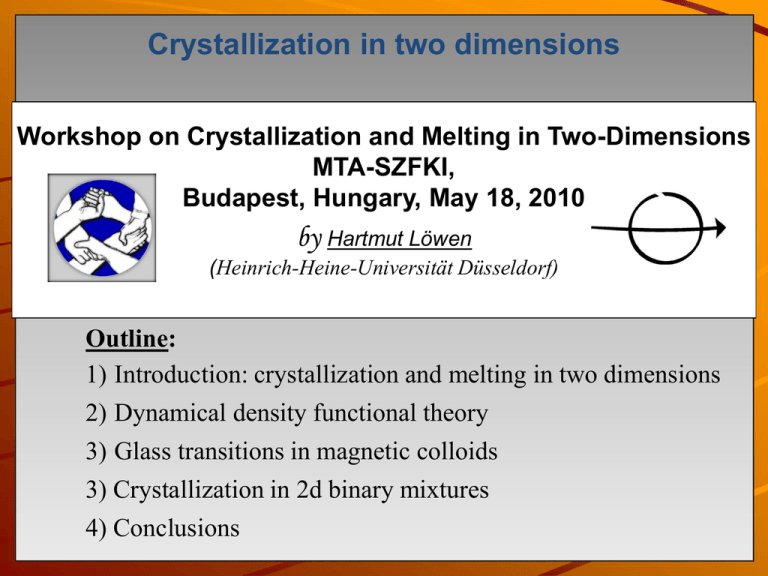
Crystallization in two dimensions Workshop on Crystallization and Melting in Two-Dimensions MTA-SZFKI, Budapest, Hungary, May 18, 2010 by Hartmut Löwen (Heinrich-Heine-Universität Düsseldorf) Outline: 1) Introduction: crystallization and melting in two dimensions 2) Dynamical density functional theory 3) Glass transitions in magnetic colloids 3) Crystallization in 2d binary mixtures 4) Conclusions Classical many body system in strict two dimensions Temperature T=0: Ground state of a repulsive potential - hard disks, - repulsive dipoles V ( r ) 1 r3 - plasma V ( r ) 1 , V ( r ) ln( r / ) r is a triangular lattice Long-range translational order, periodic density field potential energy minimization Temperature T>0: long-range translational order does not exist in 2d under certain general conditions Mermin, Wagner PRL 17, 1133 (1968) spin systems Mermin PRE 176, 250 (1968) more general mathematical proof by Fröhlich, Pfister, Communications in Mathematical Physics 81, 277 (1981) (not for plasma and hard disks) but long-ranged bond orientational order exists! Communications in Mathematical Physics 81, 277 (1981) More quantitative: correlation functions translational order, pair correlation fucnction 1 g( r ) N N g( r ) ( r ( ri rj )) i , j 1 i 1 band-orientational order r * g 6 ( r ) i ( r ) i ( 0 ) 1 i( r ) Nj e i 6 ij ( r ) j ij i j fixed reference axis g 6 ( r ) O( 1 ) for triangularlattice fluid: g( r ) 1 e r / r w ith the bulk correlatio n length g 6 ( r ) e r / solid: 6 ( r ) w ith a different correlatio n length 6 g ( r ) 1 decays algebraica lly r ( r ). g 6 ( r ) 0 ( r ) long - range orientatio nal order. s The debate about two-dimensional melting/crystallization coexistence 1) first order fluid solid 1. order 2) Kosterlitz-Thouless-Nelson-Halperin-Young (KTNHY) scenario thermal unbinding of defects disclinations fluid dislocations hexatic 2. order 2. order intermediate hexatic phase solid g( r ) 1 e r / g 6 ( r ) r 6 1 4 6 h (r ) (r ) Experimental realization of classical two-dimensional systems a) Colloids at an air-water interface (or between two parallel glass plates) b) Granulates on a vibrating horizontal table c) Dusty (complex) plasma sheets a) 2d colloidal dispersions (Keim, Maret, Zahn et al.) tilt angle • spherical colloids B confined to water/air surface normal n interface • superparamagnetic due to Fe2O3 doping • external magnetic field B 0 54.70 induced dipole repulsive no interaction moments m B ( for 0) tunable interparticle potential 2 m 1 2 2 u (r ) u HS ( 1 3 cos cos ) 3 2 r (r , B ) 900 attractive Particle configurations for different fields (Maret, Keim, Eisermann 2004) f B perp. to surface, liquid in-plane B i k B perp. to surface, crystal KTNHY scenario confirmed binary mixtures also realizable b) granulates on a vibrating table one-component hard disks: consistent with KTNHY (Shattuck et al, 2006) binary mixtures M.B. Hay, R.K. Workman, S. Manne, Phys. Rev. E 67, 012401 (2003) G.K. Kaufman, S.W. Thomas III, M. Reches, B.F. Shaw, J. Feng, G.M. Whitesides Soft Matter 5, 1188 (2009) c) dusty complex plasmas R.A. Quinn, J. Goree, Phys. Rev. E 64, 051404 (2001) Donko, Hartmann: theoretical work on 2d Yukawa consistent with KTNHY 2) Dynamical density functional theory Equilibrium Density Functional Theory (DFT) Basic variational principle: There exists a unique grand-canonical free energy-density-functional which gets minimal for the equilibrium density and then coincides with the real grandcanoncial free energy. → is also valid for systems which are inhomogeneous on a microscopic scale. In principle, all fluctuations are included in an external potential which breaks all symmetries. For interacting systems, in 3d (2d), is not known. , exceptions: i) soft potentials in the high density limit, ideal gas (how density limit) ii) 1d: hard rod fluid, exact Percus functional strategy: 1) chose an approximation 2) parametrize the density field with variational parameters gas, liquid: solid: with lattice vectors of bcc or fcc or ... crystals, spacing sets , vacancies? variational parameter Gaussian approximation for the solid density orbital is an excellent approximation 3) minimize → bulk phase diagram with respect to all variational parameters EPL 22, 245 (1993) b) approximations for the density functional + defines the excess free energy functional A) Ramakrishnan-Youssuf (RY) 1979 results in a first order solid-fluid transition (for hard spheres) dynamical density functional theory (DDFT) Starting point: Smoluchowski equation (exact) integrate out adiabatic approximation: for Brownian dynamics (colloids) (Archer and Evans, JCP 2004) ( 2) ( r , r , t) ( r , r ) ( 2) equi such that time-dependent one particle density field ( r , tis) the same 1 ( r , t ) F ( r , t ) t ( r , t ) F : equilibrium free energydensityfunctional (in excellent agreement with BD computer simulations) Dynamics of crystal growth at externally imposed nucleation clusters Idea: impose a cluster of fixed colloidal particles (e.g. by optical tweezer) Does this cluster act as a nucleation seed for further crystal growth? cf: homogeneous nucleation: the cluster occurs by thermal fluctuations, here we prescribe them How does nucleation depend on cluster size and shape? (S. van Teeffelen, C.N. Likos, H. Löwen, PRL, 100,108302 (2008)) equilibrium functional by Ramakrishnan-Yussouff (2d) hexatic phase?? (S. van Teeffelen et al, EPL 75, 583 (2006); J. Phys.: Condensed Matter, 20, 404217 (2008)) u0 2d V(r) 3 r (magnetic colloids with dipole moments) coupling parameter equilibrium freezing for u03/ 2 / k BT f 36 connection to phase field crystal models (L. Granasy et al) by gradient expansion (van Teeffelen, Backofen, Voigt, HL, Phys. Rev. E 79, 051404 (2009) procedure a) particles in an external trapping potential Vext (r) at high temperatures( 10 for )f t < 0 b) release Vext (r) and decrease T instantaneously for t > 0(enhance towards =63) imposed nucleation seed cut-out of a rhombic crystal with N=19 particles nucleation + growth 600 A 0.7 no nucleation 600 A 0.6 „island“ for heterogeneous nucleation in (cos , A) space. Brownian dynamics computer simulation strongly asymmetric in A symmetric in 3) Crystallization in 2d binary mixtures • binary spherical colloids confined to water/air interface • superparamagnetic due to Fe2O3 doping • external magnetic field B induced dipole moments mi i B tunable interparticle potential mi m j 1 Vij (r ) 2 r3 composition phase diagram at zero temperature m2 / m1 A. Lahcen, R. Messina and HL, EPL 80 48001 (2007) Some important phases X=0 X=1 X=2/3 X=1/3 X=1/2 X=1/2 Experimental snapshots at m2 / m1 0.1 and 2 / 1 1.2 11 20 100 (F. Ebert, P. Keim, G. Maret, EPJE 26, 161 (2008) composition m2 / m1 Found in experiment Ultra-fast temperature quench can be realized by increasing the magnetic field 11 5 11 78 (m 0.1) Brownian Dynamics computer simulation in agreement with experiments “patches“ of crystallites is this a glass?? dynamical heterogeneities L. Assoud, F. Ebert, P. Keim, R. Messina, G. Maret, H. Löwen, Phys. Rev. Lett. 102, 238301 (2009) non-monotonic behaviour (in time) for 2-2- structure 4) Ground state of 2d oppositely charged mixtures 3d, textbook knowledge: NaCl, CsCl, ZnS structures are stable Lattice sum minimization (penalty method for hard spheres) L. Assoud, R. Messina, H.L., EPL 89, 36001 (2010) 5) Conclusions 2d melting/crystallization is still interesting - mixtures - tetratic phase? - (2+ ) confinement (e.g. between plates with finite spacing)
